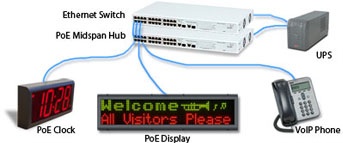POE Synchronized Clocks
A guide to PoE and why it's a smart choice for clocks and other small devices
You may already know all about Power over Ethernet (PoE) technology. You may be well-versed in the low power consumption, cost-effectiveness, and ease of installation for the hundreds of modern devices that utilize the technology, such as VoIP phones, webcams and other devices including Inova's OnTime digital clocks and, analog clocks,
What is Power over Ethernet, Anyway?
Power over Ethernet technology is a network standard that allows various devices, such as Voice over IP (VoIP) telephones, wireless LAN access points, clocks, and digital signs to receive both power and data over existing LAN cabling. In 2003, PoE became an international standard, called IEEE 802.3af, as an extension to existing Ethernet standards.
There is no need to modify your existing Ethernet switch equipment or cabling to support PoE. Simply add a midspan power injector in a switch room or endpoint to inject power into the twisted pair LAN cables. PoE is fully compatible with both powered and non-powered 10/100BaseT Ethernet devices, featuring a "discovery process" specifically designed to prevent damage to existing Ethernet equipment.

PoE switches also allow for uninterruptible power supply (UPS) backup. This means that PoE devices may continue to operate even throughout a power failure. The same can not be said for old fashioned serial-powered devices. In that case, if the power goes out...so do the devices (hope those devices weren't too important to your organization, and you don't mind manually resetting them one-by-one).
The IEEE 802.3af standard imposes a power limit of 15.4 watts, enough to operate small devices such as clocks and digital signs without sacrificing LED brightness or device quality. This low power restriction ensures that PoE devices are "green" and energy-efficient in a world moving quickly in that direction.
Overcoming Sticker Shock
A common misconception among PoE clock purchasers is that the clocks found in department stores for home use are the same clocks used in a large organization or school system. Therefore, when the novice shopper sees the price tag of a clock powered by Ethernet, they usually suffer from momentary sticker shock. "You want me to pay a few hundred dollars for a clock?"
The difference is that battery-operated clocks use outdated technology and would be an extremely inefficient choice for a large organization. Imagine having to set every clock individually, monitor each one for battery replacements, manually adjust for Daylight Saving Time and continuously check for synchronization. I'm exhausted just thinking about it.
Serial (AC-powered) clocks are hardly a better alternative. You'd need to install an AC outlet at every clock location, which typically costs a few hundred dollars itself for installation and wiring. And at the end of the day, you still wouldn't have a flexible infrastructure if the needs of the building change or if you want to add on other IP devices.
Now we arrive at the option that makes the most sense - Ethernet-powered clocks. PoE clocks receive both power and data from your organization's network and are perfectly synchronized, even across disparate locations connected by the same network. Since PoE clocks require no AC outlet installation, you've saved a few hundred dollars right there. Suddenly the original price doesn't seem so bad, does it?
Next Steps
Now that you're aware of the benefits of Power over Ethernet technology and why it is the best choice for a synchronized clock system, you'll likely need to get sign-off from management. Arm yourself with the following little facts about PoE clocks, and they can't say no:
- PoE clocks use minimal wattage, and are therefore "green" and energy-efficient.
- We are already set up to utilize PoE, with our existing Ethernet infrastructure. There is no need to modify our switches or cabling. PoE won't damage our existing equipment.
- Clocks that get time updates from our own network will be completely synchronized. Synchronized time is crucial for security systems and efficient operations.
- PoE allows for centralized UPS backup, which will allow the clocks and other Ethernet-powered devices to operate even through a power failure.
- We can avoid the manual maintenance involved with battery-powered clocks, and the hefty installation costs involved with serial clocks. PoE clocks automatically update for Daylight Saving Time.
- PoE devices are protected by the same measures that keep our network secure.
- We can easily add additional clocks or other PoE devices to our network in the future. This would be a costly and cumbersome endeavor with serial-powered devices.

